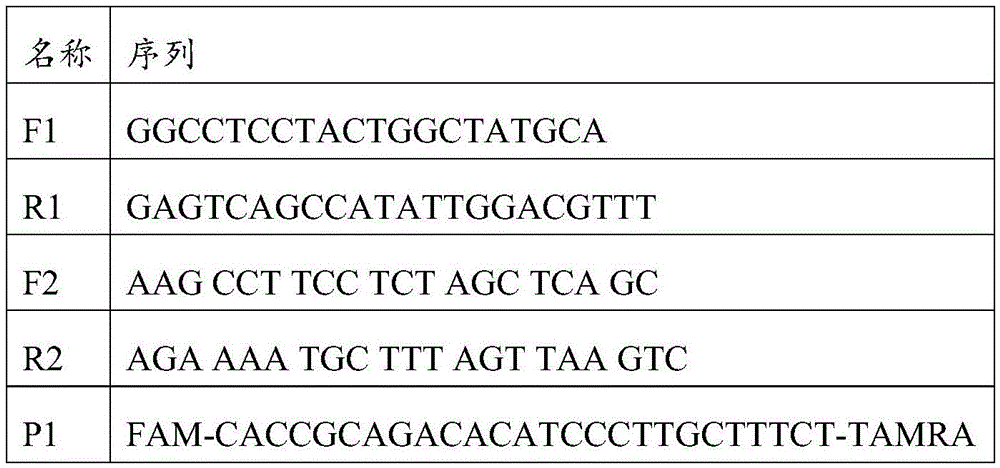Duck-derived material droplet type digital PCR (Polymerase Chain Reaction) absolute quantitative detection kit
A detection kit, micro-droplet digital technology, applied in the direction of microbial measurement/inspection, biochemical equipment and methods, etc., can solve the problem of inability to detect adulterated samples, can not reflect the core concept of digital PCR, fluorescent PCR technology detection Low lower limit and other problems, to achieve the effect of high sensitivity
- Summary
- Abstract
- Description
- Claims
- Application Information
AI Technical Summary
Problems solved by technology
Method used
Image
Examples
Embodiment 1
[0035] Design and screening of embodiment 1 primers and probes
[0036] 1. Design of primers and probes of the present invention: purchase 2 kinds of commercially available meat ducks, 1 kind of shelduck duck, and 1 kind of wild duck, and design according to the duck (Anasplatyrhynchos) mitochondrial genome sequence (HM010684.1) published by Genbank to amplify the duck The general primers of the 813bp partial sequence (61-873) of the cytochrome b gene were extracted from the total DNA of different varieties of duck as templates, and the specific primers suitable for ddPCR were designed. This example gives the process of screening the best primers, select several pairs of alternative primers designed by software for screening, the alternative primers are as follows, see Table 1.
[0037] Table 1
[0038]
[0039]
[0040] 2. Screening of primers
[0041] (1) The primers are randomly matched into four pairs: F1R1, F1R2, F2R1, F2R2;
[0042] (2) Then use the dye method to ...
Embodiment 2
[0049] Example 2 Optimization of the annealing temperature of the PCR method for detecting duck-derived components on the ddPCR platform.
[0050] 1. Select the combination of primers and probes as: F2R2+P2.
[0051] 2. Then on the ddPCR platform, ddPCR system formula: 2XddPCRSupermixforprobes10μL, upstream primer, downstream primer 1μL, probe 0.5μL, RNaseFreedH 2 O3.5 μL, positive template 4 μL, total volume 20 μL (concentration of both primers and probes is 10 μM). Do 8 replicate wells and generate microdroplets.
[0052] 3. Amplify on a PCR instrument. The PCR amplification program is 95°C for 10 minutes; 94°C for 30 sec; reaction. Detection on the droplet digital PCR detector.
[0053] 4. Analyzing results: Select an annealing temperature of 55-58°C according to the experimental results.
Embodiment 3
[0054] The optimization experiment of embodiment 3 primers, probe concentration
[0055] The concentrations of the designed primers and probes were all 10 μM, and the combination was F2R2P2. The system configuration method is shown in Table 2.
[0056] Table 2
[0057]
[0058] Then micro-droplets were generated on the ddPCR platform, transferred to a 96-well plate, and sealed with an aluminum film.
[0059] Amplify on a PCR instrument, and the PCR amplification program is 95°C for 10 minutes, denaturation at 94°C for 30 sec, and annealing at 58°C for 60 sec, a total of 40 cycles; 98°C for 10 min to end the reaction. Detection on the droplet digital PCR detector.
[0060] Analysis results: Select the F2R2+P2 primer-probe formula according to the experimental results: 1.8 μL for primers and 0.6 μL for probes.
PUM
| Property | Measurement | Unit |
|---|---|---|
| Sensitivity | aaaaa | aaaaa |
Abstract
Description
Claims
Application Information
 Login to View More
Login to View More - R&D
- Intellectual Property
- Life Sciences
- Materials
- Tech Scout
- Unparalleled Data Quality
- Higher Quality Content
- 60% Fewer Hallucinations
Browse by: Latest US Patents, China's latest patents, Technical Efficacy Thesaurus, Application Domain, Technology Topic, Popular Technical Reports.
© 2025 PatSnap. All rights reserved.Legal|Privacy policy|Modern Slavery Act Transparency Statement|Sitemap|About US| Contact US: help@patsnap.com



